At the end of the 2021/22 campaign, after a magnificent season back in the top flight where they almost won the Belgian Pro League, Felice Mazzù left his post as Royale Union Saint-Gilloise to become manager of Brussels rivals RSC Anderlecht.
The Belgian side did not have to look far to find his replacement, with USG promoting Mazzù’s assistant Karel Geraerts to the managerial post, giving the 41-year-old Belgian his first manager’s job.
So far, Geraerts has had huge success as boss, with the club sitting in second place in the Pro League, one win away from the final of the Belgian Cup.
Also, even though he failed in qualifying them for the group stages of the UEFA Champions League after losing out on aggregate in the playoffs to Rangers, the Belgians have also had great success in the UEFA Europa League.
Union Saint-Gilloise are into the last 16 of the competition after topping a group featuring Union Berlin, SC Braga, and Malmö, only losing once in six group stage matches.
This Karel Geraerts tactical analysis and Union Saint-Gilloise scout report will look at how USG like to set up in different phases of play, as well as the tactics that Geraerts looks to utilise in each phase.
Karel Geraerts Formations At Royale Union Saint-Gilloise
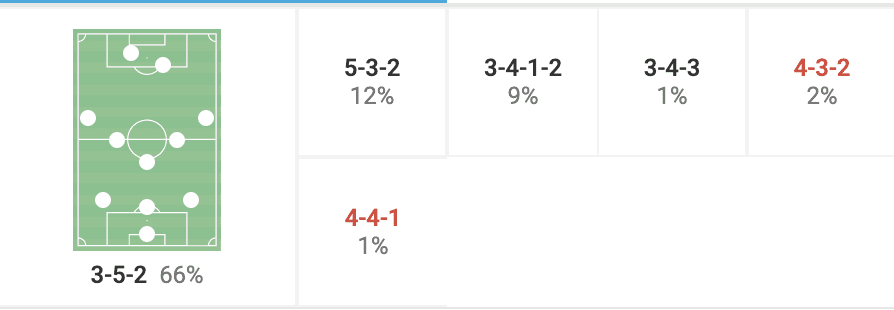
When it comes to a preferred formation for the Belgian side, Geraerts has stuck with what brought USG so much success last season under Felice Mazzù, with a 3-5-2 being used by the 41-year-old the majority of the time this season as well.
He also was able to retain the majority of the core players that had huge success with the Brussels-based outfit last season, with Deniz Undav and Casper Nielsen being the most notable departures in the summer.
With the success that Union Saint-Gilloise had last season, many expected their squad to be picked apart in every position, but that was not the case, and this allowed Geraerts to continue to build on what Mazzù achieved last season, as well as put his own tweaks on the style of play.
Chance creation from the wide areas
Under Geraerts this season, Union Saint-Gilloise have been a side that primarily creates chances from the wide spaces.
A lot of these chances come from crosses into the box from the two wingbacks, normally Loïc Lapoussin and Bart Nieuwkoop, who like to get forward and support the attacks.
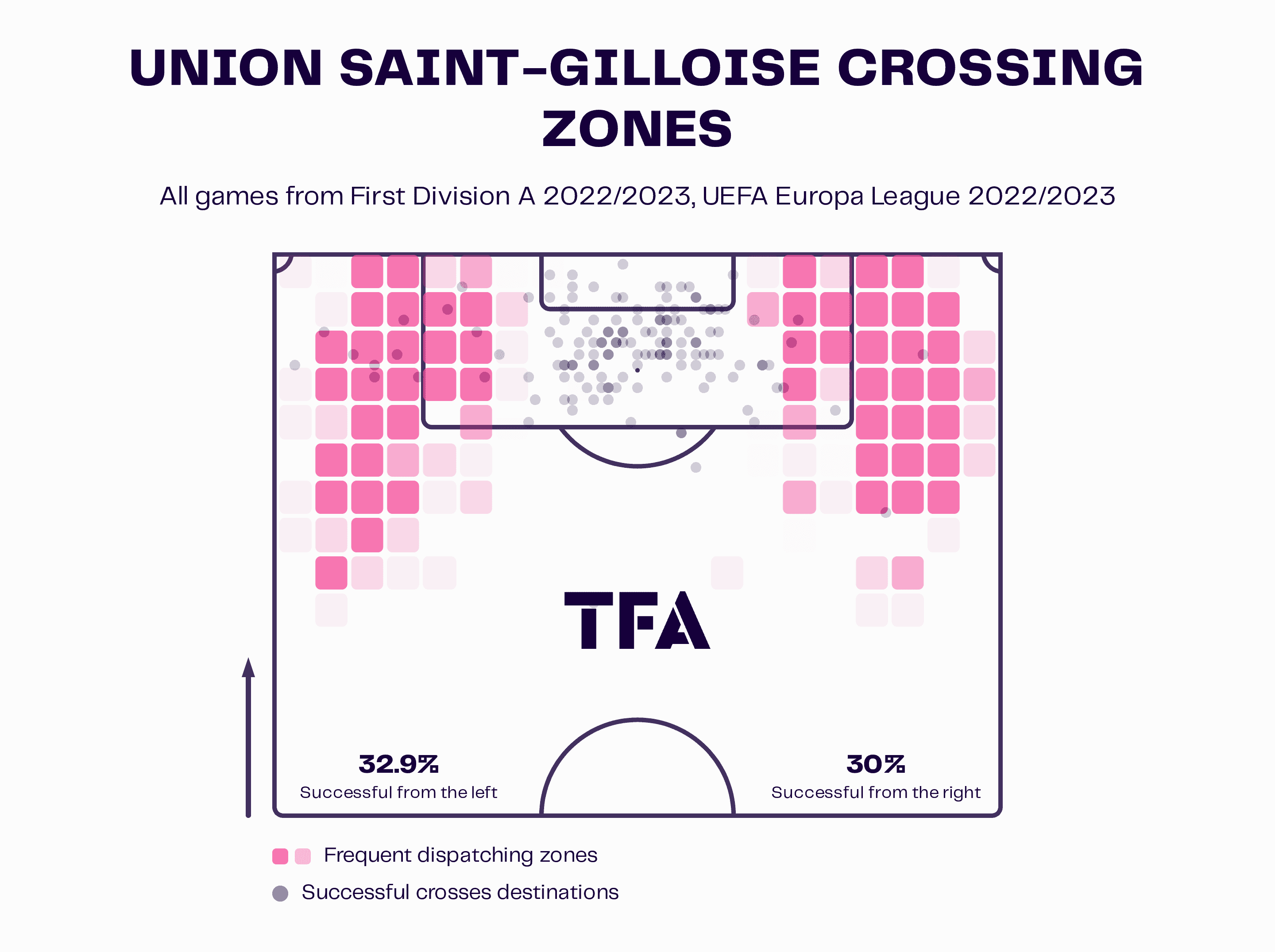
The data viz above shows where the majority of Union Saint-Gilloise’s crosses have originated from on both the left and right side.
As we can see by the colouring of the frequent dispatching zones of these crosses, a good amount of them actually get served from the half spaces between the midfield and defensive lines, with the crosses usually being aimed at and around the penalty spot.
The Belgian side is also quite accurate when it comes to their services from wide, with 32.9% being successful from the left, and 30% from the right.
This means around one in every three crosses reaches its target, which then results in quality chances on goal for USG.
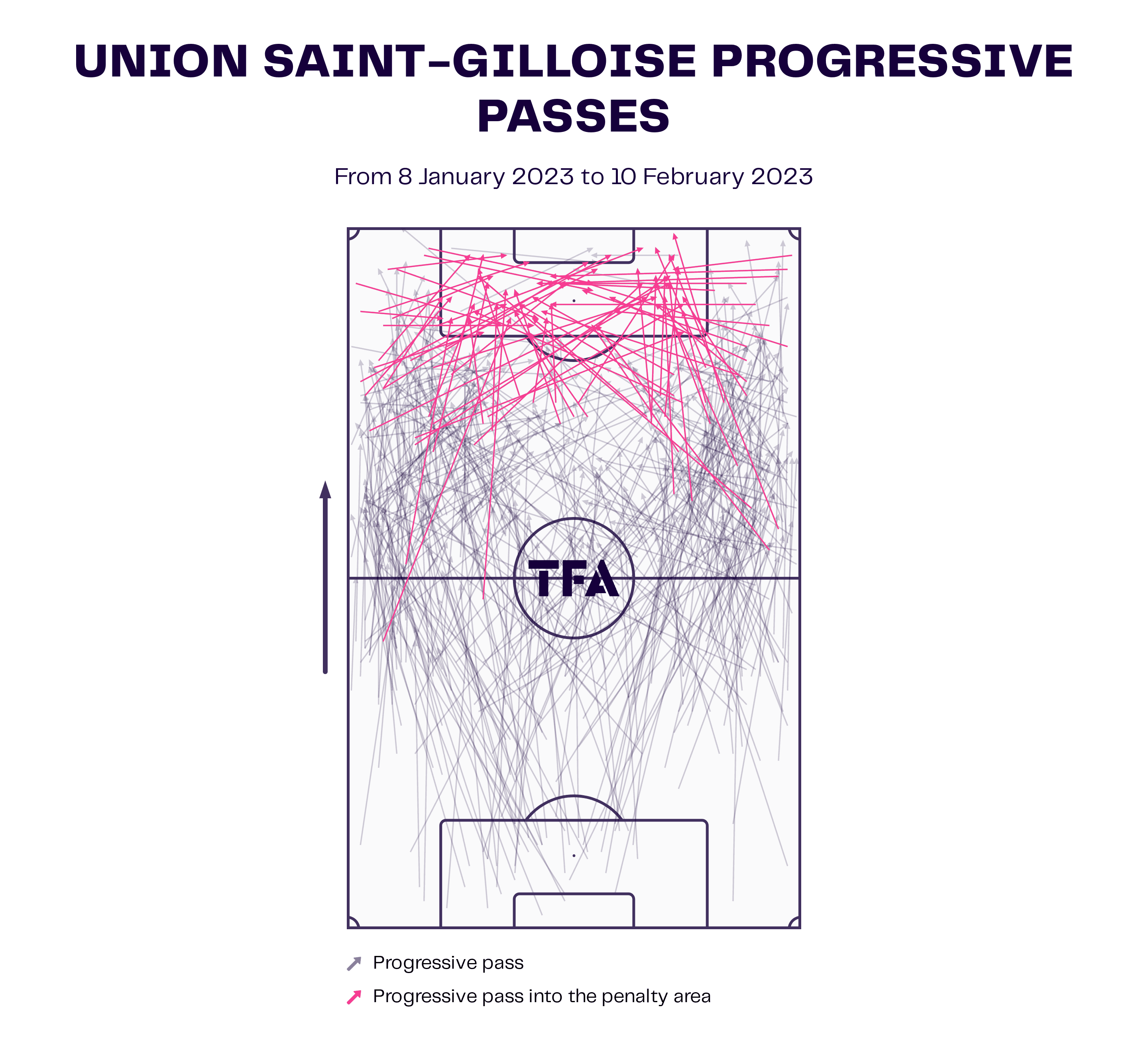
When it comes to the frequent tendency for Union Saint-Gilloise to attack from the wide areas, it is not only from crosses that they can progress into goalscoring areas from these wide channels.
Geraerts’s side also uses quite a lot of one-touch and combination passing, looking to get runners free beyond the opposition’s defensive line so that they can play in on goal.
They also look to create overloads in these wide areas, creating passing triangles and using these combination movements to break quickly through the opposition’s defence.
The data viz above shows a recent range of Union Saint-Gilloise matches, stretching from the beginning of January to their most recent game against Antwerp in the first leg of the Belgian Cup semi-final.
It displays the progressive passes of the Belgian side from these matches, with it highlighting the number of times one of these progressive passes into the penalty box originates from one of the wide channels.
Being able to properly exploit these wide channels is something that Karel Geraerts looks for his side to utilise, with it paying dividends for the Belgian side so far this season.
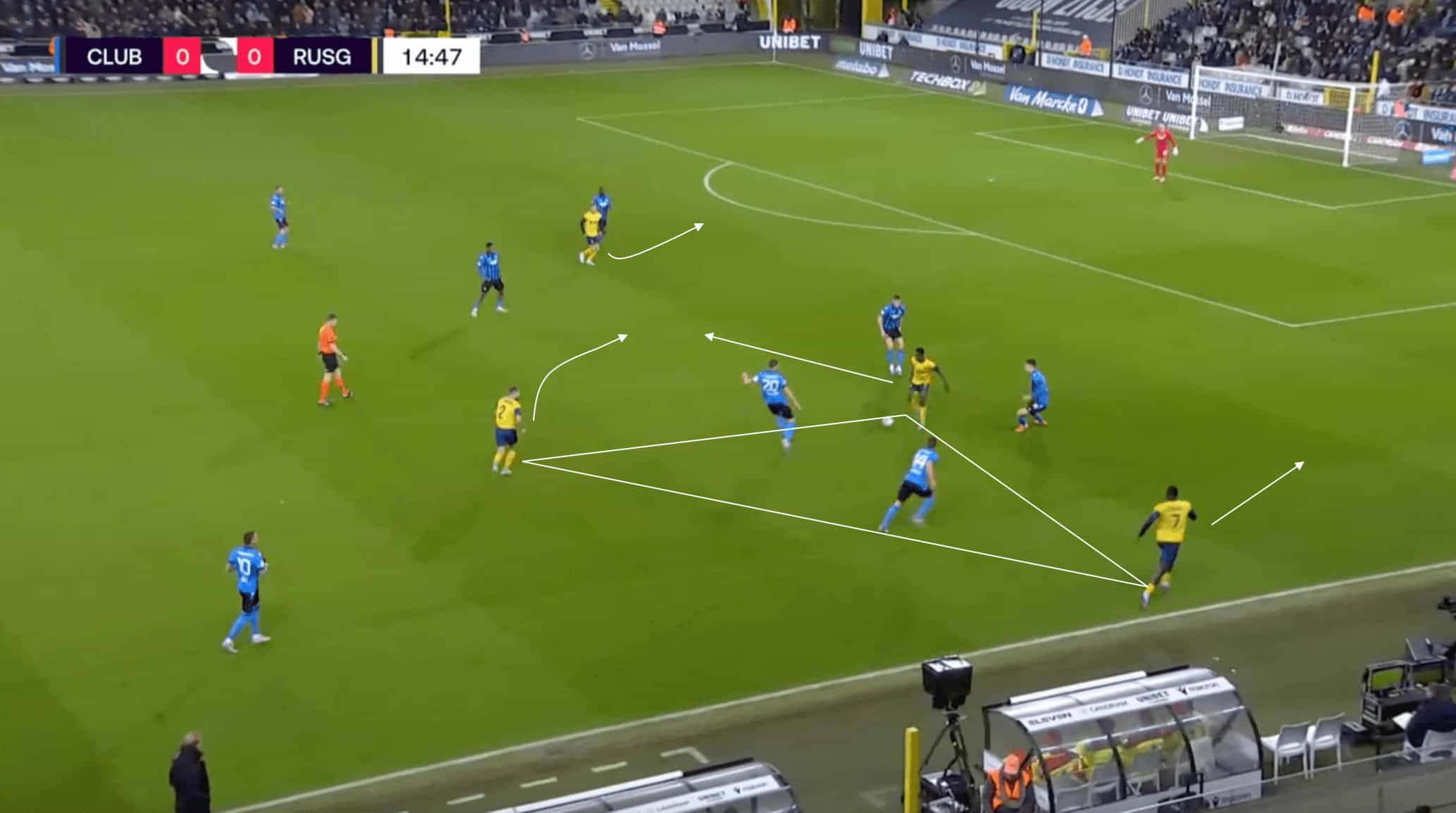
The image above shows one of these combination movements that were able to catch the Club Brugge defence out.
In this phase of play above, USG have created a triangle on the near-side wide channel, with the wing-back’s pass to the central player able to attract the attention of the Club Brugge defenders in proximity.
As the defenders get attracted to the ball, both the central run of Nieuwkoop and the outside run of Boniface are potential options for the player in possession to find with a one-touch pass.
The ensuing pass is played centrally, allowing Nieuwkoop to run onto the pass and attempt a ball to find Yorbe Vertessen, who is positioned as the most advanced player for this particular attacking move.
The move continues with an attempted one-two between the aforementioned players but eventually breaks just outside the penalty box.
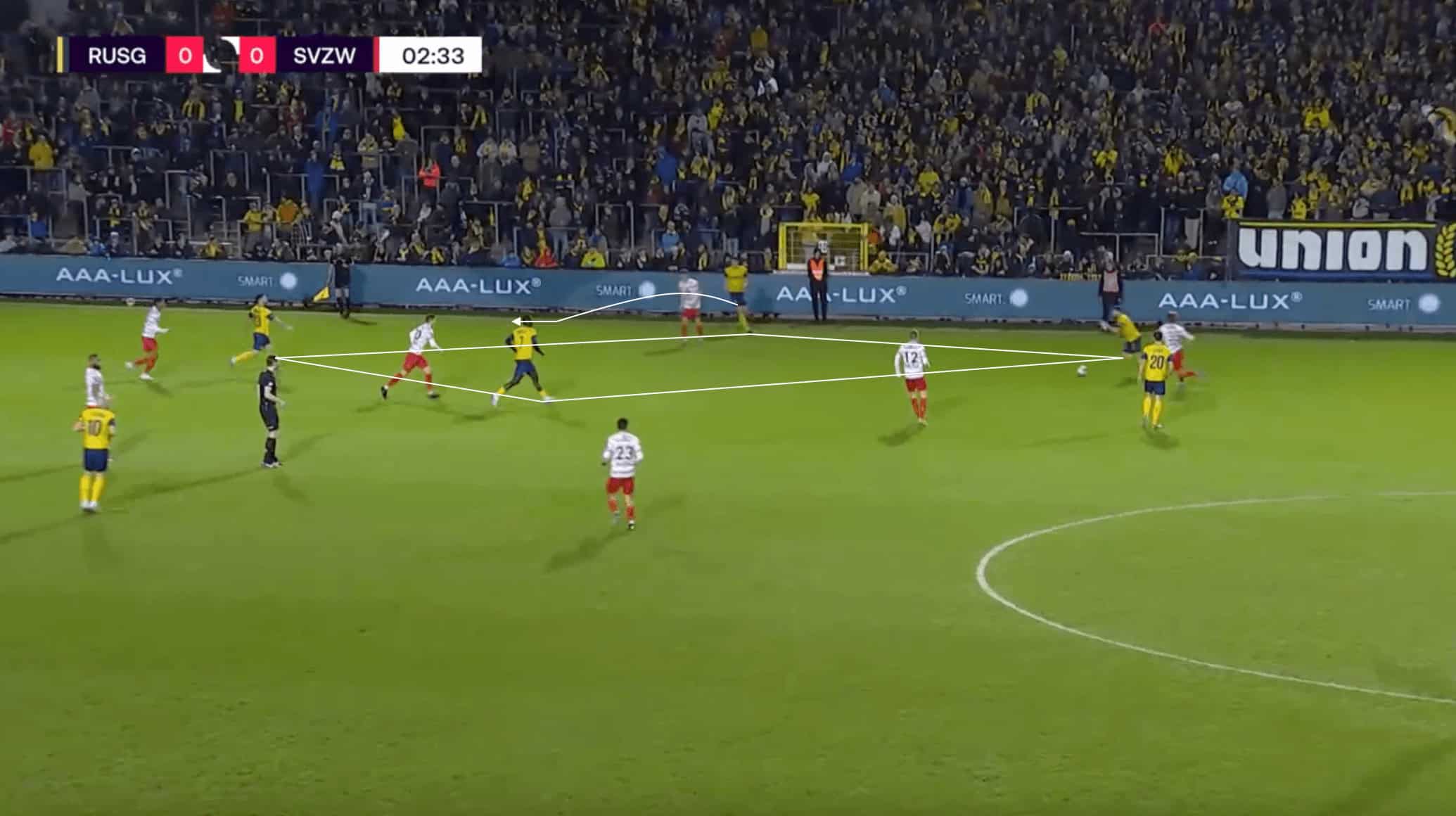
The above shows another example of the quick one-touch combination passing sequences that Union Saint-Gilloise look to catch opposition defences out with in wide spaces.
In the above phase of play, USG have four, arguably even five players positioned in the wide channel, which allows them to create an overload against the Zulte-Waregem defence.
This attacking phase also shows Karel Geraerts’s principle of using verticality when his side reaches the attacking third.
While USG will look to play the ball horizontally if the passing options are not there in advanced positions, these one-touch passing combinations allow the Belgian side to quickly cut through the opposition.
In the match above against Zulte, all of the USG players are crucially in front of their markers, which allows any of them to show as an option.
The ball is played vertically to the highest player, with the ball then attempted to be played first-time into the path of the runner behind the fullback.
Though this move breaks down, it shows the clinical quickness that Union Saint-Gilloise can attack with.
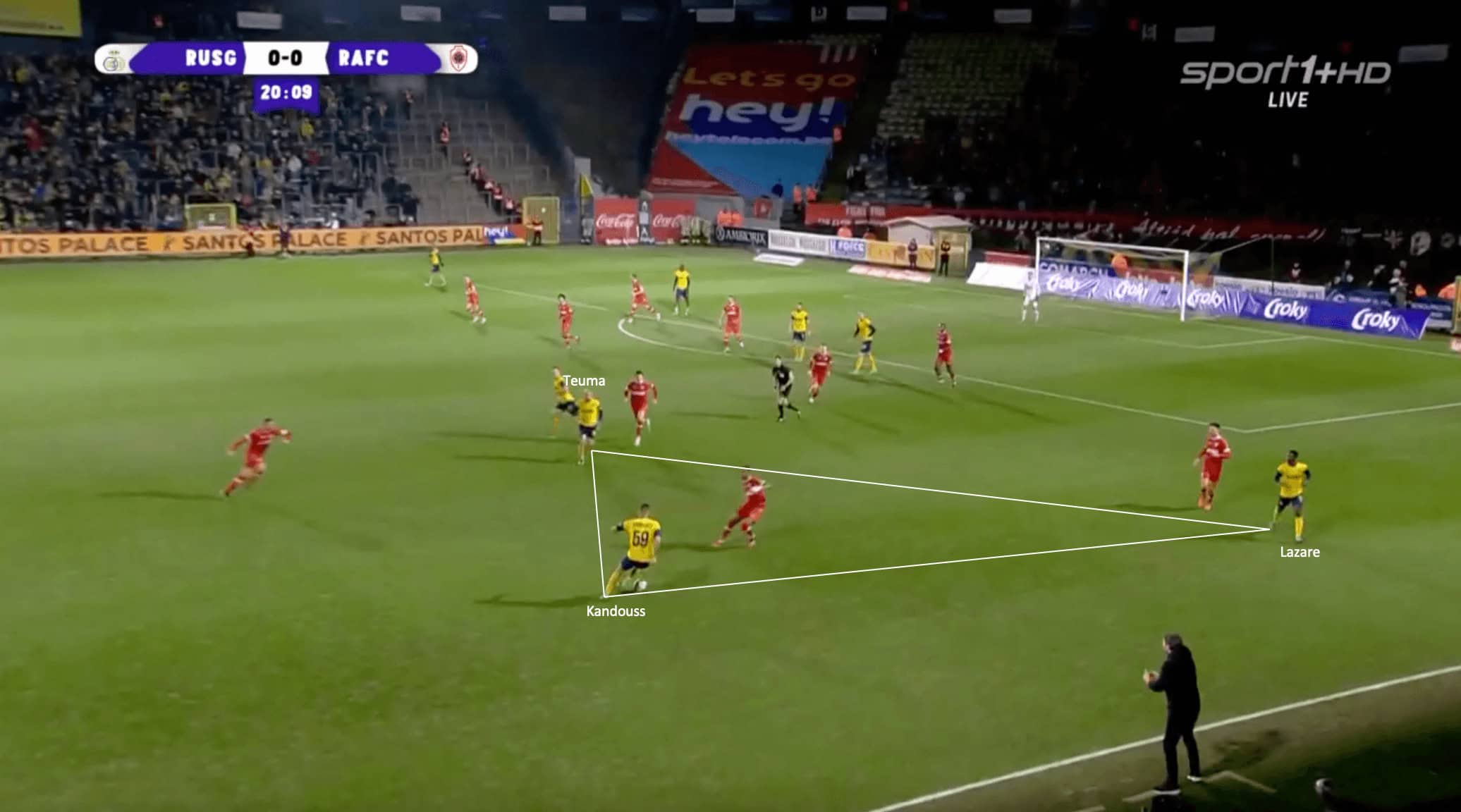
The image above again shows the triangle passing combinations that Geraerts’ Union Saint-Gilloise side looks to create in the advanced wide areas.
In this specific phase of play, Ismaël Kandouss, a centre-back, drives forward in possession to create the triangle with Teddy Teuma and Lazare Amani, with this movement of the three players creating a temporary 3v2 overload in the wide channel.
Antwerp did well to shift quickly and nullify the overload that formed, with this attacking move not being the most fast-paced and clinical.
Still, again, it shows what Karel Geraerts is looking for his side to do from an offensive standpoint, which has worked to great success this season so far.
Whether an attacking move ends in a cross played into the box, or just passing with verticality in the wide channels to quickly progress the ball, Union Saint-Gilloise’s use of space creation, overloads, and passing triangles in these wide areas has resulted in much success going forward for them this season under Karel Geraerts.
Sound defensive structure
When it comes to a defensive standpoint for Union Saint-Gilloise, they are one of the best sides in the league at keeping the ball out of their own net.
In the Belgian Pro League so far this season, USG have conceded 25 goals, which is tied for second least (Genk), with only Antwerp having conceded fewer than them this campaign (23).
A lot of this defensive solidity comes down to the formation that Karel Geraerts sets his side up in, a 3-5-2.
When USG lose possession, this shifts into a 5-3-2, with the wing backs dropping into the defensive line.
The Belgian side also stay tight and compact in this defensive shape, making sure they do not leave space for sides to play between their lines.
They also stay quite rigid, not allowing themselves to be pulled out of their defensive structure often.
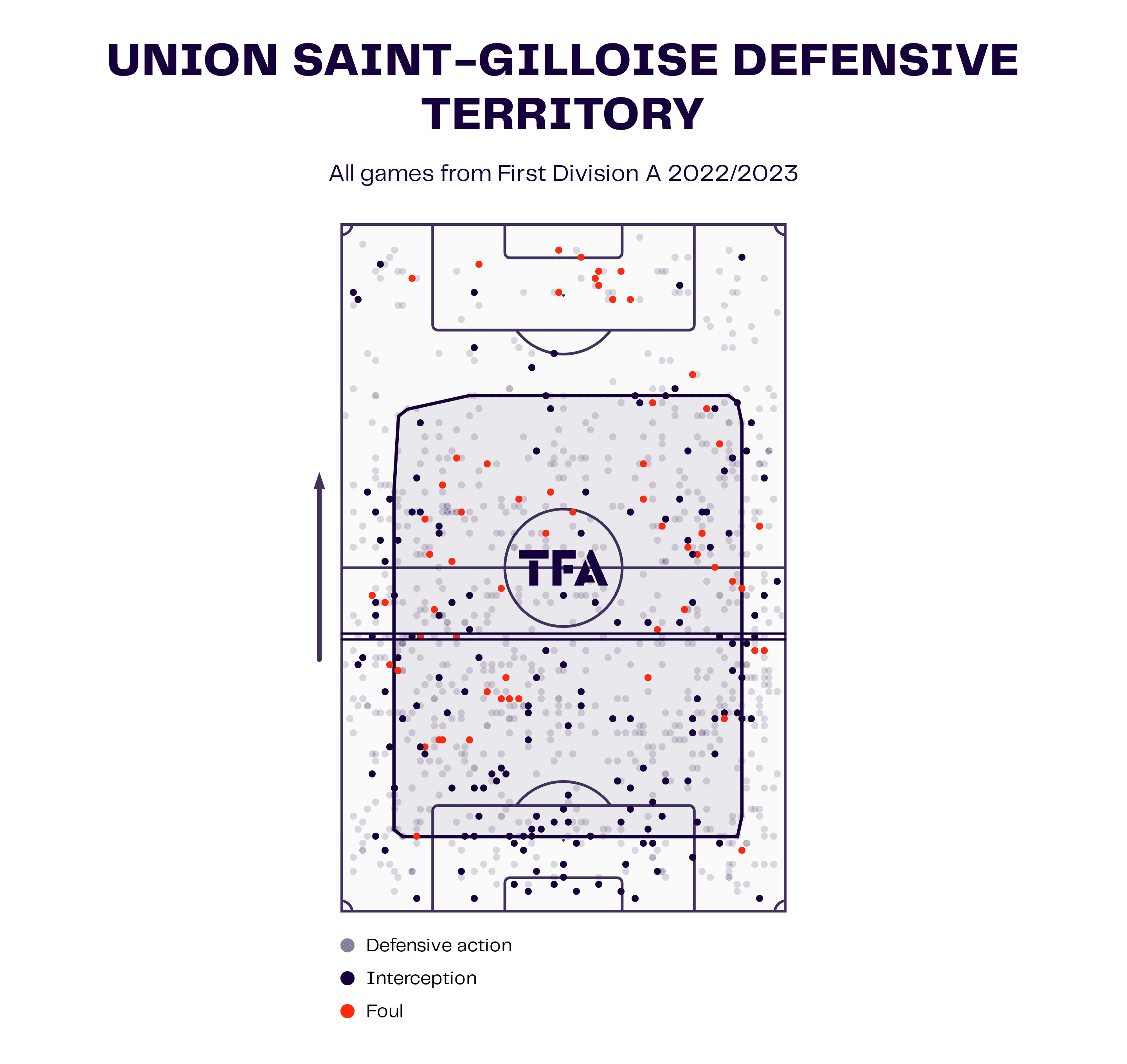
The data viz above shows the defensive territory of Union Saint-Gilloise, along with the average height of their defensive line.
As the graphic shows, they sit rather deep, with the average height of their defensive line being inside their own 18-yard box.
This helps to illustrate the compactness of their defence, with their opposition holding more possession than them on average.
They are a danger to sides when it comes to their transitional play, especially when they can play quickly and clinically, as the previous section highlighted.
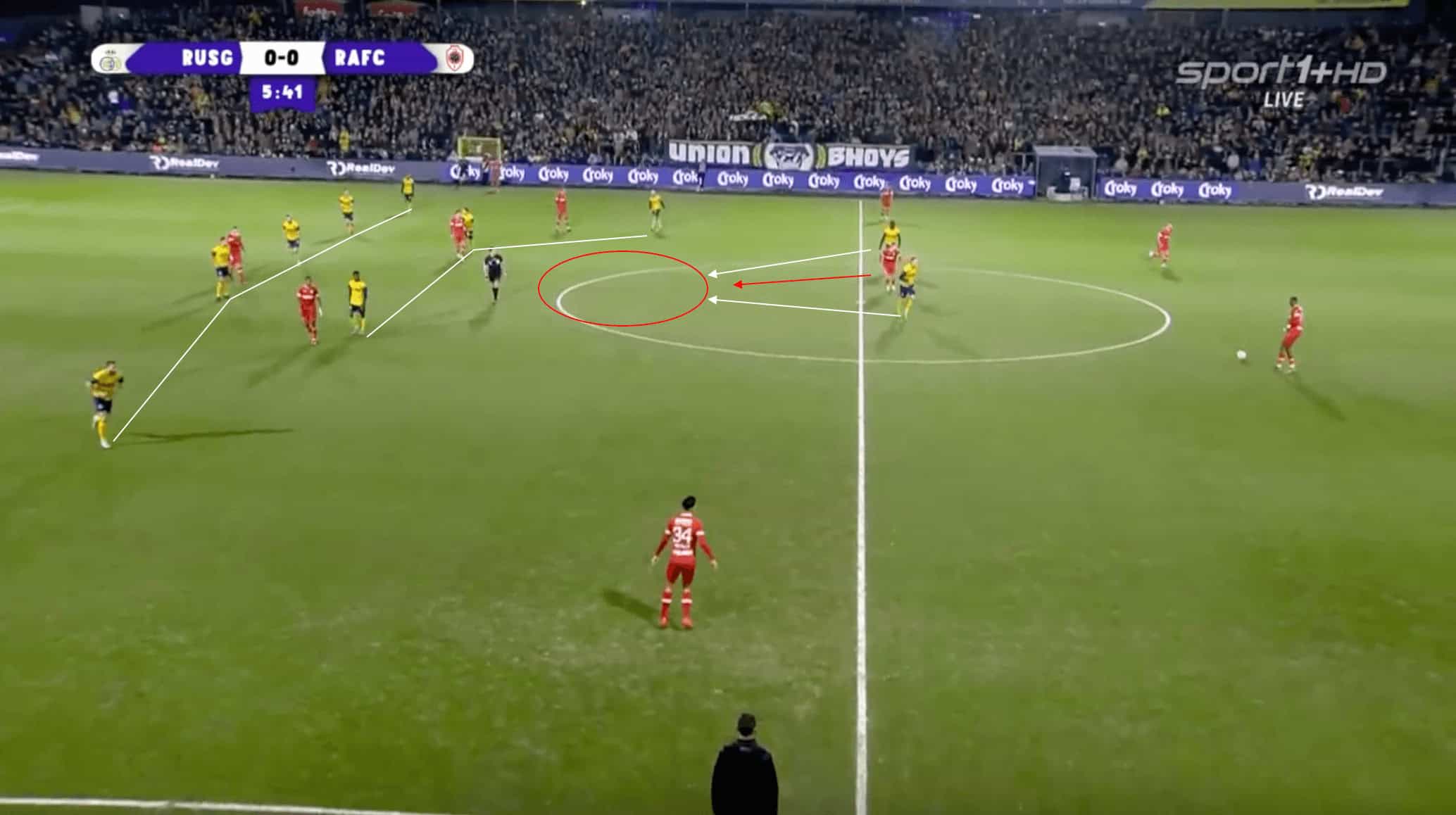
The image above shows an example of the typical defensive shape that Union Saint-Gilloise set up in when the opposition is in possession.
As we can see, the back five and the midfield three stay rigid and compact, which prevents opposition attackers from finding space in between the lines.
The front two normally stay a bit more advanced, which allows them to put pressure on the opposition centre-backs near the halfway line who will normally push up in possession.
The space normally is between the forward and midfield lines, but most often, opposition sides have no choice but to progress the ball by playing to the wingers or fullbacks out wide, which then allows the USG defensive shape to slide and attempt to pin the ball to one side.
However, if the opposition do attempt to play into the midfield, the Union Saint-Gilloise forwards quickly close them down along with the midfielders, with the goal being to quickly dispossess the opposition and transition.
This is exactly what happens here against Antwerp.
They eventually get frustrated playing side-to-side and play the ball to the space between the lines, but they are instantly closed down and lose possession, which allows USG to transition quickly and attempt to catch the Antwerp defenders out.
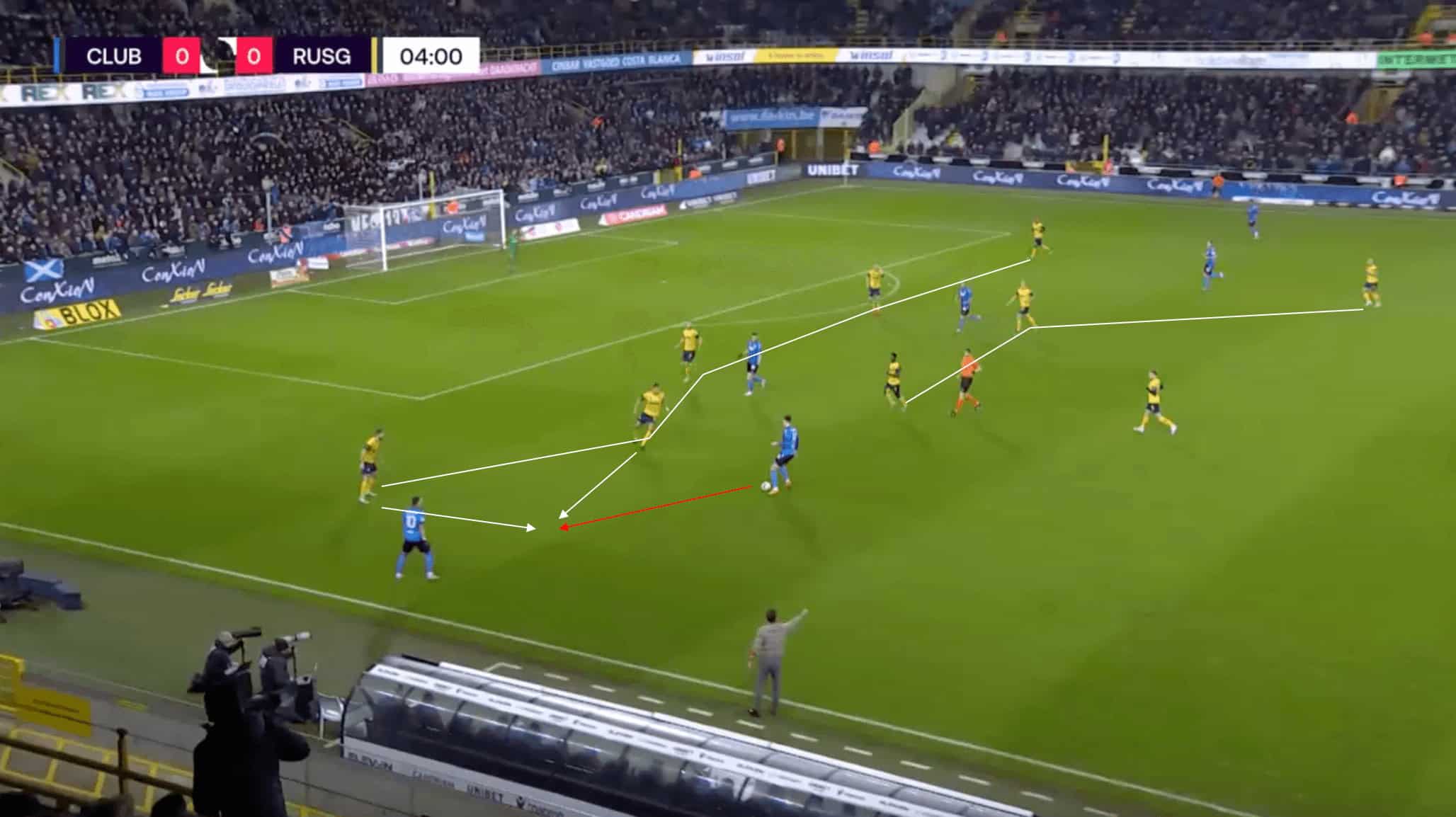
A similar defensive situation is shown in the image above, this time with the opposition in a much more advanced position.
We can again see the rigid and compact 5-3 defensive shape, with one of the forwards also dropping into a deeper position to support.
The defensive shape is able to quickly slide and stay compact as Club Brugge moves the ball to this near touchline.
When the player in possession reaches this position, the USG defenders then step out of their line to go and engage, essentially locking the ball into one side and preventing the switch of play.
As a result, Club Brugge are forced to attempt to play a ball in behind the back line of Union Saint-Gilloise, but fail, with the defence holding strong and allowing the Belgian side to regain possession and begin a quick transitional move.
All in all, the defensive structure that Karel Geraerts has implemented during his time in charge at Union Saint-Gilloise has been mostly successful so far.
A rigid and compact 5-3-2 shape limits any spaces that the opposition may be able to find between the lines, which forces them to play out wide, allowing USG to then engage the ball receiver and lock them into one side.
However, leaving a bit of a gap between the midfield and forward defensive lines gives opposition defenders a bit of false hope, thinking they can squeeze passes into the space.
This then provokes the USG players into closing down the space quickly, allowing them to win back possession and quickly transition into the attacking phase.
A dangerous counterpressing side
While USG are not a side that will always look to be on the front foot defensively, as the last section illustrated, they are dangerous when they lose possession in the attacking third due to their high tendency to counterpress.
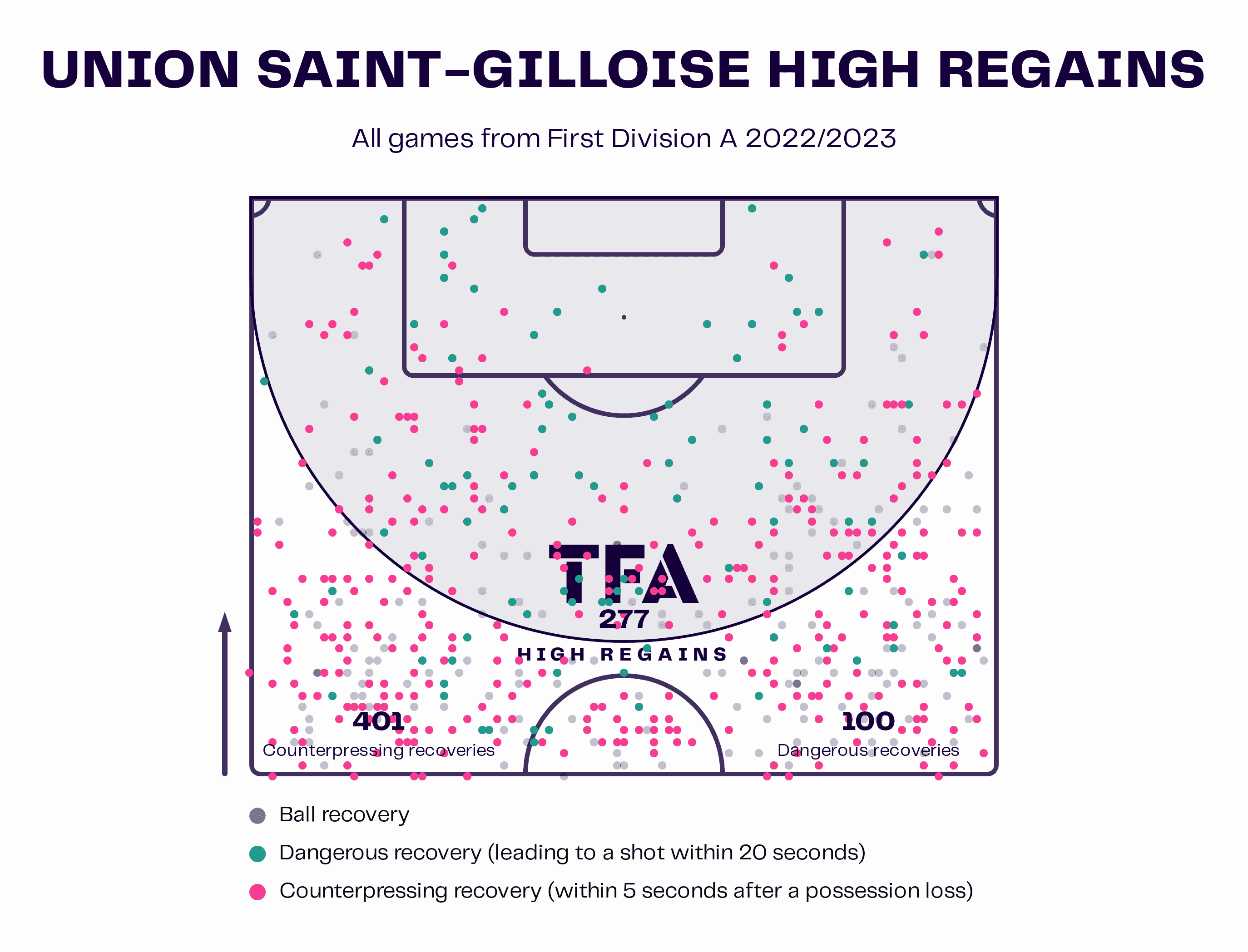
The data viz graphic above shows all the high regains that Union Saint-Gilloise have successfully completed this season so far.
As the graphic displays, they have had 401 counterpressing recoveries, the second-highest number in the Belgian league, with 100 of them being dangerous recoveries, so leading to a shot within 20 seconds.
The first five seconds after USG lose possession are key for them, as that determines whether they stay on the attack or drop back into their rigid and compact defensive shape.
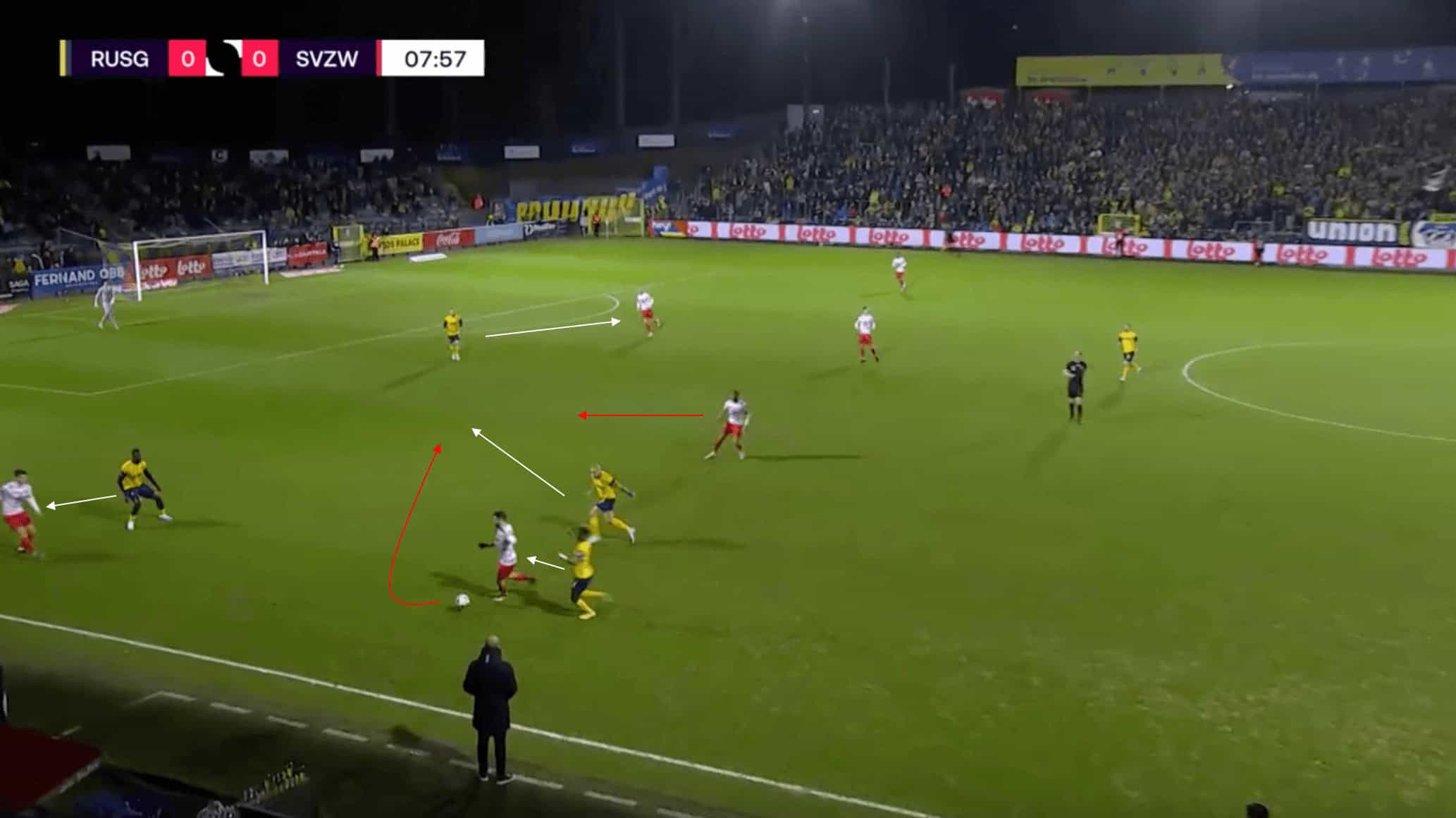
The image above shows an example of the dangerous counterpressing that allows Union Saint-Gilloise to win back possession in dangerous areas in the attacking third.
After losing possession in the phase of play pictured above USG went on the offensive, looking to quickly win possession back in a dangerous area.
The Union Saint-Gilloise players do well with their positioning in the counterpressing phase, with every free option for the Zulte player to pass to marked.
The Zulte player in possession out wide is put under pressure from behind, which forces him to play an errant pass into the central area looking for his teammate.
Teddy Teuma does really well to position himself on the blind shoulder of the player in possession, with him able to intercept the pass and quickly set USG off on a counterattack, which after a few quick passes, leads to a Union Saint-Gilloise goal.
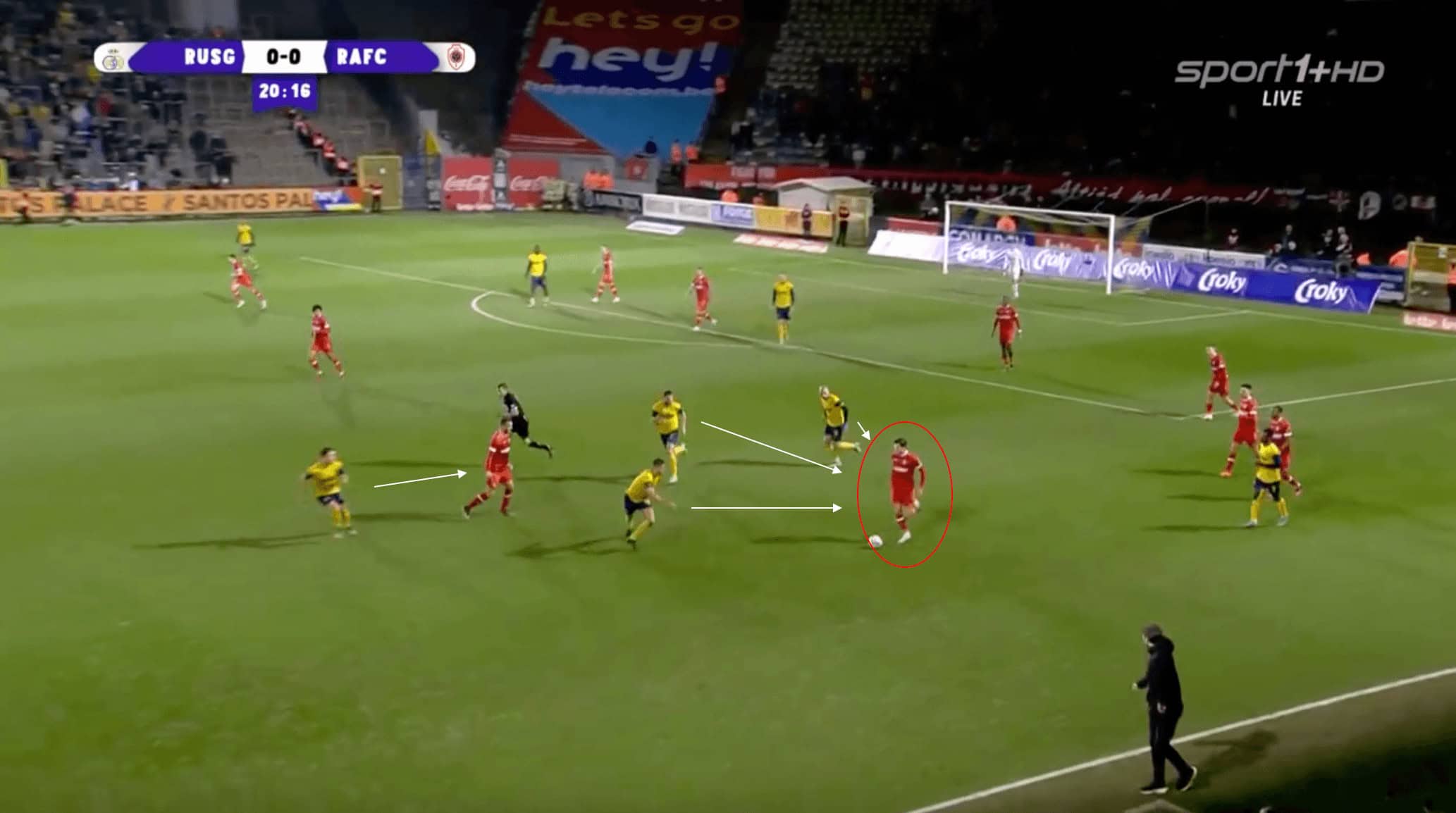
The image above shows another example of the dangerous counterpressing recoveries that Union Saint-Gilloise are capable of, this time against former Barcelona and Bayern Munich player Mark van Bommel’s Royal Antwerp.
In the phase of play above, USG lost possession, with them turning it over near the edge of the penalty box.
As soon as Antwerp got on the ball, the three closest Union players instantly engaged the ball receiver, forcing him into playing the ball to the USG player sitting in a deeper position due to being put under immense pressure.
This allows the Union Saint-Gilloise attack to continue in an advanced area as a result of the pressure and turnover.
While they may not be an aggressive front-foot defending side under Karel Geraerts, Union Saint-Gilloise look to counterpress often in advanced areas, allowing them to stay on the front foot while the ball is still in an advanced area.
Conclusion
Under Karel Geraerts, Union Saint-Gilloise have arguably been better than they were last season under Felice Mazzü, a season where they almost won the title in their first season back in the top flight.
Geraerts has been able to juggle being involved in European competition well, with the Belgian side finishing top of their Europa League group.
They also currently sit second in the Belgian top flight, with Geraerts looking to go one step further than his predecessor.





Comments